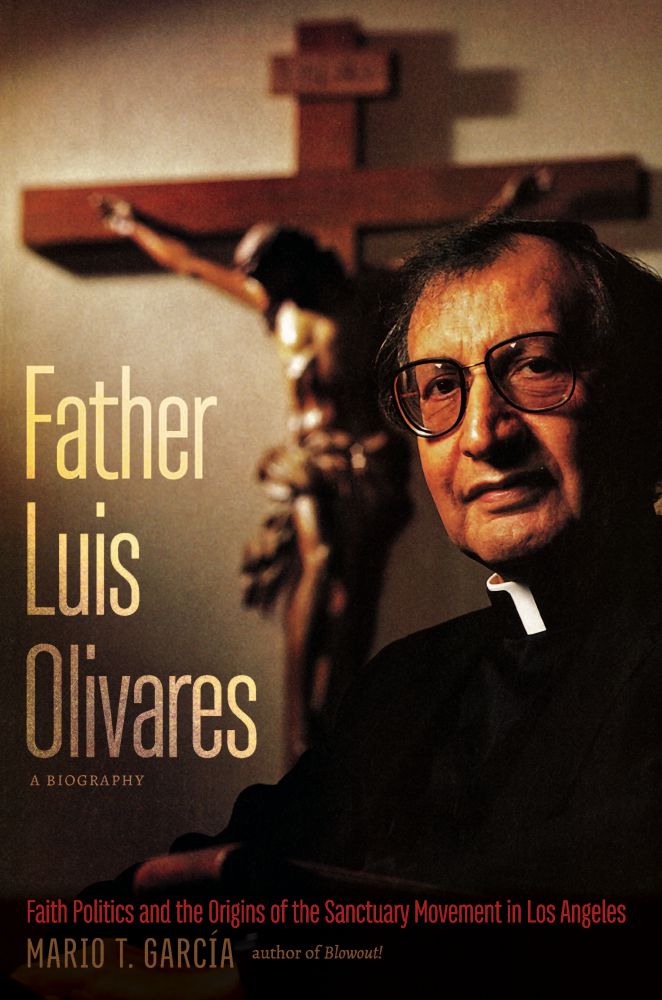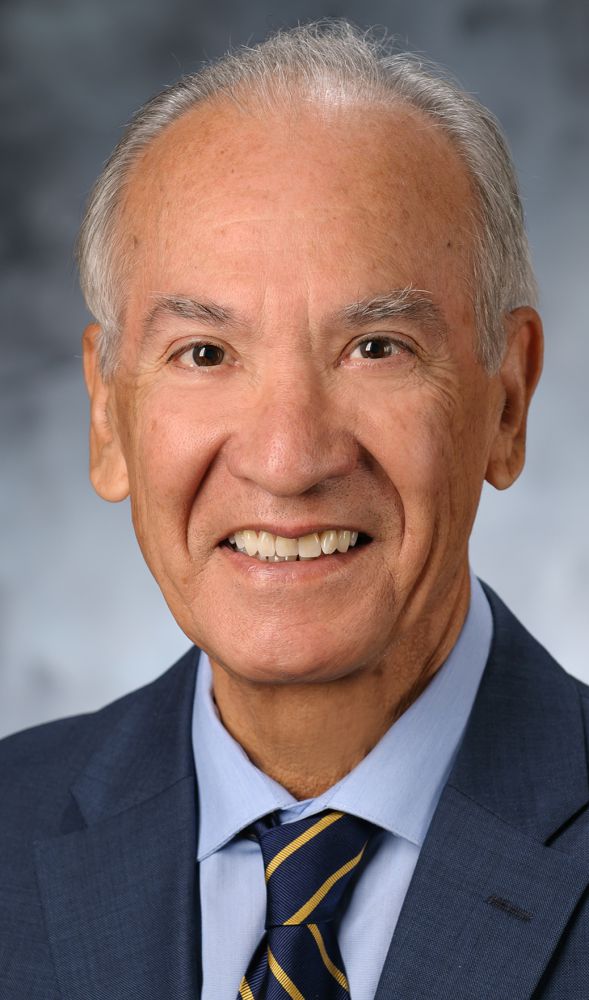
A Journey of Service

Father Luis Olivares had it made. As treasurer of the Claretians, a congregation of Catholic missionaries, he was wined and dined by the titans of Wall Street. They flew him to New York first class, put him up in five-star hotels, took him to the best restaurants and treated him to Broadway shows.
“He even played up the part in the way that he dressed,” said Mario T. García, a UC Santa Barbara professor of Chicano and Chicana Studies. Velvet suits, French cuffs, Gucci shoes — Olivares cut a fine figure. “In fact, some people began to refer to him as ‘the Gucci priest.’ ”
And then he walked away from the titans of finance to serve the poor and the unwelcome — and never looked back.
Olivares’ journey from a darling of Wall Street to the champion of Central American refugees and undocumented Mexican immigrants is chronicled in García’s “Father Luis Olivares — A Biography: Faith Politics and the Origins of the Sanctuary Movement in Los Angeles” (University of North Carolina Press, 2018).
The first full biography of the celebrated priest, the book comes at a time when the U.S. again grapples with new arrivals from Central America and Mexico. García said we can learn from Olivares.
“People need to know that in the not-too-far past people were working on the same issues,” he said, “and that they were successful in helping these people, and giving them hope, and standing up and saying, ‘No, this cannot happen. We as Americans do not accept the way these people are being treated. This is not who we are. This is not what American is, to treat people in this inhumane and demeaning way. They are human beings; they are children of God and they need to be treated as such.’ ”
Born in 1934 in San Antonio, Texas, to political refugees from Mexico, Olivares grew up in what García called “a giving family, very religious, very Catholic.” His mother died in childbirth, and he was strongly influenced by his paternal grandmother, a devout woman who was active in helping the poor during the Great Depression. At 14 he followed his brother Henry, who was a year older, and enrolled in a Claretian seminary in Compton, Calif. After finishing his studies at Catholic University in Washington, D.C., he fulfilled his life’s ambition and was ordained in San Antonio in 1961.
Olivares was what García called “a company man,” and it didn’t take long for the Claretians to notice his talent and ambition. Bright and committed, he was named treasurer of his order, responsible for its multimillion-dollar portfolio of investments. Wall Street came calling.
But then, so did fate, in the form of César Chávez. Olivares met the legendary labor organizer in 1975 and, in his own words, underwent a “conversion.”
“He began to question what he had been doing, and his role as a priest,” García said. “He turned things around, encouraged by what César was doing with the farm workers, and he began to move in a totally new direction to become what I call a community priest.”
Olivares helped Chávez with the grape boycott in East L.A., and requested assignment as a pastor in the heavily Latino region of the city. He became involved with the United Neighborhoods Organization (UNO) working with working-class immigrant communities. And he was just warming up. He also became a key organizer in an effort to force auto insurance companies to bring down inflated rates in lower-income areas like East L.A.
“It was a great success and it literally put UNO on the political map,” García said. “Olivares became the public face of UNO, and he learned how to organize and he learned what it took to get the media involved and how you put together these kinds of actions where you bring pressure.”
In 1981 Olivares moved to La Placita church at Our Lady Queen of Angels in downtown L.A., the signature church for the Catholic archdiocese.
About that time refugees from Central America, especially El Salvador, began streaming into the U.S. to escape that country’s brutal civil war. It was estimated that 100,000 Salvadorans came as refugees, with half of those going to Los Angeles. The Reagan administration, however, regarded them as “illegal aliens” — even though other countries and the U.N. recognized them as political refugees.
Olivares didn’t hesitate. He welcomed them into the parish, fed and clothed them, helped with jobs and health care, and funneled some into an underground railroad to other parts of the U.S. or Canada, which recognized them as legitimate refugees.
On Dec. 12, 1985, at a mass on Feast Day of Our Lady of Guadalupe, Olivares declared La Placita a public sanctuary. It was the beginning of an extraordinary run for the sanctuary movement and the priest who became a symbol of hope for refugees and the undocumented.
Olivares’ work came at a cost, however. By openly defying the Reagan administration, he drew the wrath of the Immigration and Naturalization Service, which worked to investigate and discredit him. Olivares was not deterred.
“All through this it’s faith that carried him,” García explained. “He believed in God’s law. He always said that yeah, he might be breaking the law, but for him there was always a higher law, and God wanted his children to be protected, including the refugees and the undocumented immigrants.”
But Olivares soon faced pressure from within the church. Archbishop Roger Mahony, named to lead the L.A. Archdiocese in 1985, initially supported Olivares and the sanctuary movement. But Mahony gave way to business and political pressure and backed away, García said.
What’s more, Mahony came from Fresno, where he served as Bishop and was active with farm workers. García said he thinks Mahony didn’t know he was going to share the spotlight in L.A.
“I think Mahony had come to L.A. thinking, given his own background earlier, that he was going to become the champion of Mexican-American and Latino Catholics,” García said. “He could see the writing on the wall that the future of the Catholic Church, certainly in L.A. and Southern California, was going to be the Latino Catholics because of demographic changes. He came believing he was going to be their champion, only to find they already had a champion. And that was Father Olivares. So that created a rivalry.”
By the end of the ’80s, through what García called “indirect pressure” from Mahony, the Claretians told Olivares he was being transferred to Fort Worth, Texas. Olivares protested that his work was in L.A., but the order stood.
Olivares never left Los Angeles. In June 1990 he awoke feeling sick. Tests revealed he had AIDS. He succumbed to the disease in 1993.
“Of course there were rumors after he was diagnosed,” García said. “But the importance of Olivares is not that he contracted AIDS, but what he did with the rest of his life, and what his life represents.”
Above all, García wants people to remember how Olivares “was able to go through that conversion and apply himself to put into practice his faith, and in essence to call for a new kind of Catholic Church and a new kind of Catholic priest. A church that would be open for the poor, a church that would go beyond the border of the parishes and into the community to help people, especially the poor and the oppressed, and a new kind of Catholic priest who would also go beyond the borders of their parishes and go out and help organize people and help them in any way possible.”
Dialogue with the author
García will discuss Olivares and the sanctuary movement in a dialogue with Verónica Castillo-Muñoz, a UCSB associate professor of history, Thursday, Nov. 29, from 4 to 5:30 p.m. in the McCune Conference Room on the sixth floor of the campus’s Humanities and Social Sciences Building. The event is part of the Interdisciplinary Humanities Center’s “Humanities Decanted” series. It is sponsored by the IHC’s Harry Girvetz Memorial Endowment and the Department of Chicana and Chicano Studies.



